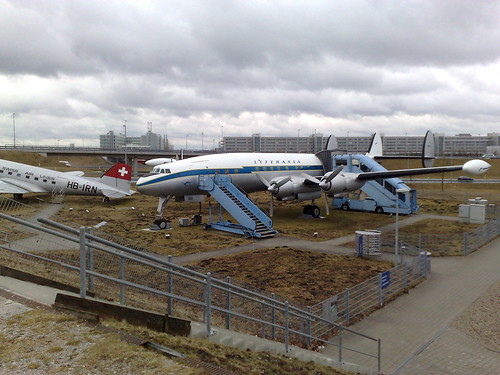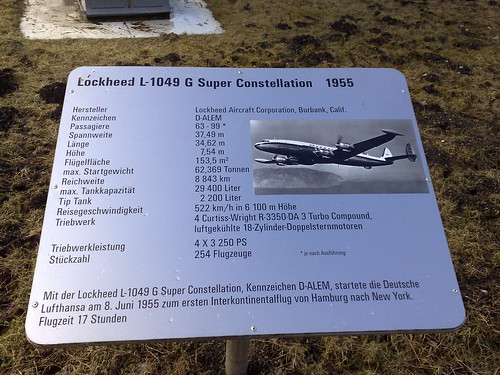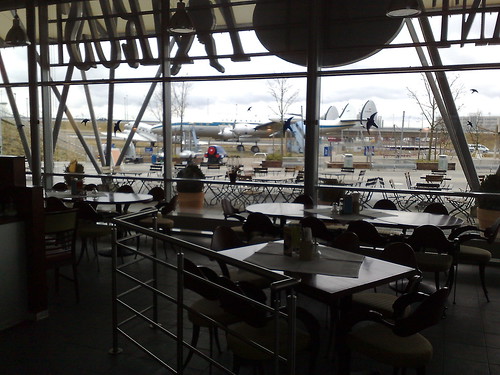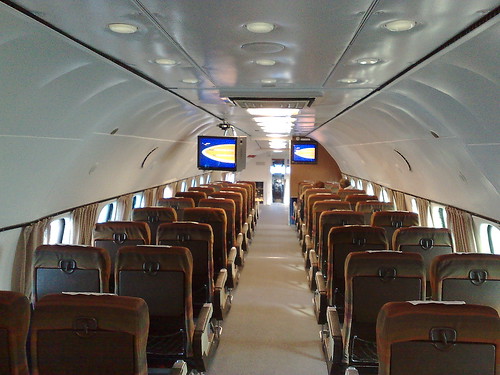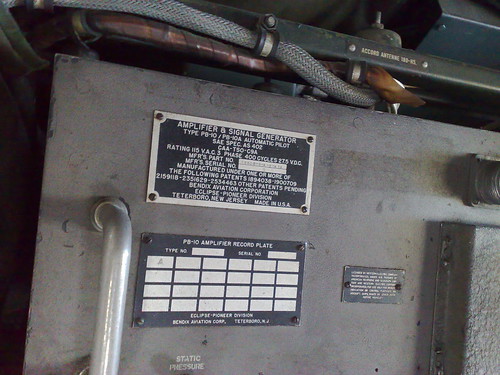This 40-ton airliner was designed for Pan-Am and also ordered by Trans World Airways (TWA), courtesy Howard Hughes -- a big stakeholder at TWA.
The Constellation could cruise at 330 mph at 20,000 ft. So impressive were the design specs that TWA ordered nine, even before the design was off the drawing boards at Burbank, California.
It captured the spirit of the post war years. The high-lift low-drag elliptical wings were based on Lockheed's P-38 Lightning fighter.
The Connie made air-travel affordable for the common public. Its tremendous range made the world a smaller place.
One of Air-India's earliest Connies was called the "Malabar Princess". Registration:VT-CQP. (construction no. 2506) She arrived in India on 16th Mar. 1948.
First International Flight
On Tuesday, 8th June 1948, piloted by Capt. K.R. Guzdar, “Malabar Princess” VT-CQP operated Air-India’s first international flight Bombay->Cairo->Geneva->London.
Among the 42 high-profile passengers on India's historic international commercial flight were: Mr. J.R.D.Tata, Nawab Amir Ali Khan (1926-2004) the Jam sahib of Nawa Nagar (now called Jamnagar) and film producer Keki Modi father of Roosi Modi of the Tatas.
Tragic Loss
Two years later, on the morning of 3rd Nov. 1950, tragedy struck the Malabar Princess.
While flying Air-India flight 245, VT-CQP crashed at 15,000 ft. in the French Alps, killing 8 crew and 40 passengers. Commanded by Capt. Alan Saint, a veteran British pilot, she struck the slopes of Mont Blanc in the French Alps in heavy snow and high winds, while on descent into Geneva killing all 40 passengers and 8 crewmembers aboard. Barely 20 metres higher and she would have cleared the peak.
Severe Alpine weather, complicated the search for survivors.
Capt. Alan Saint reported his last position to Grenoble ATC, 10 minutes before disappearance from radar. At that time she was 80 km SE of Lyon, at 4,700 m.
A Swissair plane discovered the wreckage, while flying above Mont Blanc. Two days later, rescuers found the wreck of the "Malabar Princess" 200 metres below the summit, at 4,671 m on the rock of the Tournette, 300m Vallot hut.
None of the 45 on board survived. Most of the passengers were Indian and Pakistani seamen joining ship in North England.
A full French movie was made in 2004 about Air-India's Connie , "Malabar Princess" starring Jacques Villeret.
A very strange coincidence is that Air-India's Boeing 707-437 jetliner registration VT-DMN, named Kanchenjunga crashed at the same spot on Mont Blanc, killing Dr. Homi Bhabha in the mid-1960s.
As the snow on Mont Blanc melts due to global warming, bits and pieces of the original Malabar Princess come tumbling down the mountain. There is a restaurant at the base of the mountain that exhibits these artifacts. Relics and remains of Air-India's first Connie.
A main landing gear from the Constellation is on display at the Chalet des Glacier des Bossons, located on the left bank of the Glacier du Bossons on the edge of the Moraine. The glacier flows for almost five miles and 11,500 feet down Mount Blanc at an average rate of about 900 feet per year. The base of the glacier is located in the Chamonix Valley and for the past twenty years airplane parts have been regularly spit out of glacier.
The landing gear was found by Christian Mollier, owner of the chalet, in front of the chalet’s restaurant in 1986. It is often not possible to determine whether some parts are from the Connie or the 707-437 but the landing gear are definitely from the Constellation.
Many of the parts found at the base of the base are in good condition despite having been encased in ice for over 55 years.
My neighbour Mr. K.G.Ramaswamy was a flight engineer on Super Connies and 707s. As a saucer-eyed kid, I learned much about aircraft from him. Connies had a pilot, copilot, flight engineer, navigator, radio officer, ... Large crew.
I would love to have a scale model of the Connie, "Malabar Princess" in Air-India colors, in my living room.
When my late father lived in Europe in 1962, he flew to Rome in a Super Connie in 1962.
I was always fascinated by the roaring rumbling noise of these big birds and the burned petrol 150 Octane smell of its exhaust gases. Stuff of my childhood memories.
Sitting down with a cup of coffee offered by aunt Ramaswamy and listening to Mr. K.G.Ramaswamy uncle talk about hydraulics and control surfaces.
Back in those days, Air-India would fly Bombay, Aden, Rome, Geneva ...
On Sat. 2nd Feb. 2008, I visited the Besucherpark(Visitor Park) in Flughafen München(Munich Airport), Bavaria, Germany and took a close look at a Super Connie.
Took the following photos of the Lockheed L-1089 Super Constellation -- one of my favorite piston-engined propeller-driven airliners.
Lockheed Super Constellation L.1049G , constr. no:4671.
Preserved by Lufthansa at Franz Josef Strauss International Airport, Munich.
The registration: D-ALEM is fictitious. Originally it was Air-France's F-BHML The real D-ALEM, was a Lockheed Super Constellation L.1049G c/n:4603 which was scrapped by Lufthansa.
The chronologically closest Air-India aircraft was a Lockheed Super Constellation L.1049G c/n:4613, named "Rani of Nilgiris", registered as VT-DHL. Rani of Nilgiris was sold to the Indian Air Force as BG-580, resold to the Indian Navy as IN-317 and eventually scrapped by the Indian Navy.
Right three-quarters view of the old bird -- one of the most elegant aircraft to ever grace the skies!!.
A plaque fixed in front of the nose wheel states:
"With the Lockheed L-1049G Super Constellation, Registration D-ALEM, Lufthansa of Germany started on 8th June 1955, their first Intercontinental flight from Hamburg to New York.
Flight time: 17 hours."
Viewed from the cozy Restaurant Ikarus at Besucherpark, Flughafen München.
First class was in the rear (aft) portion of the Super Constellation -- the quietest section of the fuselage.
The Super Constellation has been cleaned, painted. The cabin is outfitted with two video monitors that continuously play a Lufthansa movie on the days of the Super Constellations. The cabin looks roomier (reduced tube-effect) because the overhead drop-down beds have been removed.
Curtiss-Wright R-3350 Turbocompound engines
View from one of the Super Constellation's port-side windows
Raindrops on the Windowglass and the Curtiss-Wright R-3350 Turbocompound engines against the Restaurant Ikarus. The blue turnstile charged €1 for admission to the aircraft.
Here is a Port side closeup of the Curtiss-Wright Turbocompound engines. The Curtiss-Wright R-3350 Turbocompound on the Super Connie had 18-cylinders arranged in two-stars and equipped with 3 exhaust gas turbines which fed power back to the crankshaft, developing 3,250 shp per engine.
View of the port wing. Note the two Curtiss-Wright R-3350 Turbocompound 18-cylinder engines and the 1,100 litre wingtip fuel tank.
Dimension M is a multimedia show at the Besucherpark.
Cockpit
Clear in this pic are the elevator trim wheel, aileron trim, rudder trim, thrust levers and propeller pitch levers and flight engineer's instruments against the right wall.
The L.1049 were the first aircraft equipped with a flight director, ILS Zero-Reader and a failure analyzer (CRT engine vibration and sparkplugs), which allowed for detecting dysfunctional plugs.
Much after ILS was introduced, glidepath and glideslope were shown on an indicator with two ILS needles (one vertical and one horizontal).
Heading and altitude were corrected with tiny aileron and throttle adjustments, to keep both needles centered, staying precisely on the indicated glide slope (vertical path indicated by horizontal needle) and glide path (horizontal path indicated by vertical needle).
Super Connies had a crew of five:
Captain/Commander, First Officer (copilot), Second Officer (flight engineer), Navigator and Radio-operator.
This is the Flight Engineer's station. Besides controlling the manifold pressure with the throttles, RPMs with the propellers pitch, fuel mixture leaning, proper positioning of the cowl flaps, and spark advance, he was also responsible for fuel management, air conditioning, pressurization, anti-icing and de-icing, etc.
Super Connies even had an ignition analyzer, and a sharp Second Officer could even tell if any one of the 144 sparkplugs was not firing properly!
As it was originally built for Air-France, all the callouts are in French!
Eclipse-Pioneer PB-10 autopilot
The Eclipse-Pioneer PB-10 analogue electronic autopilot (by Bendix of Teterboro, NJ) maintained altitude and airspeed by automatic control of the elevators and throttles.
Amplifiers drove aileron, rudder and elevator servo motors.
Modern airliners today, of course, have fully digital flight control systems.
Control Cables
Back in 1955, physical cables from the flight-deck operated the aircraft's control surfaces, throttle, mixture, propeller-pitch,...,
Routed over pulleys!
This aircraft has had a portion of its flooring cut away and replaced with glass to showcase the cables, bundled electrical wiring and hydraulic plumbing.
One can also see bulkheads, ribs and spars. Small as it may be by present day standards, a super Connie still has over 43 km of cabling. She generates enough electricity to light up a small village.
A glass window over the cutaway floor reflected daylight entering from the Superconnie's windows. Shooting with available light, I couldn't avoid the reflections!
Centre and Port Vertical stabilizers

The quintessential triple tail of the Super Connie.
Why did the Connie have three vertical stabilizers?
So that they could get it into the low roof hangars in the 1950s, without compromising tailfin surface area.
The enormous fifteen foot propellers, required an unusually tall undercarriage for adequate ground clearance. Had the Connie had a single vertical stabilizer, it would not have fit into any of TWA's hangars. So it was designed with three vertical stabilizers, which could split the surface area amongst themselves.
The three tailfins were barely 24 feet 9 inches above the ground.
Compare that to today's Boeing 747 with a vert. stab. that's 63 ft. 8 in. tall. And the new Airbus A380 with a 79 ft. tall tailfin.


